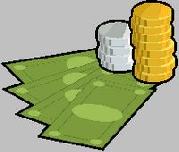
 |
|
| Financial Terms | |
| Equipment |
|
Information about financial, finance, business, accounting, payroll, inventory, investment, money, inventory control, stock trading, financial advisor, tax advisor, credit.
Main Page: payroll, accounting, business, tax advisor, investment, financial advisor, finance, inventory control, |
Definition of Equipment
EquipmentThe cost of equipment owned by the company.
Related Terms:Equipment trust certificatesCertificates issued by a trust that was formed to purchase an asset and lease it PROPERTY AND EQUIPMENTAssets such as land, buildings, machinery, and equipment that the business will use for several property, plant, and equipmentThis label is generally used in financial Property, plant, and equipmentThis item is comprised of all types of fixed assets Plant and EquipmentBuildings and machines that firms use to produce output. Capital expendituresAmount used during a particular period to acquire or improve long-term assets such as Conditional sales contractsSimilar to equipment trust certificates except that the lender is either the  Depreciation tax shieldThe value of the tax write-off on depreciation of plant and equipment. Direct leaseLease in which the lessor purchases new equipment from the manufacturer and leases it to the Double-dip leaseA cross-border lease in which the disparate rules of the lessor's and lessee's countries let Fixed assetLong-lived property owned by a firm that is used by a firm in the production of its income. Foreign direct investment (FDI)The acquisition abroad of physical assets such as plant and equipment, with Full-service leaseAlso called rental lease. Lease in which the lessor promises to maintain and insure the Long-term assetsValue of property, equipment and other capital assets minus the depreciation. This is an Operating leaseShort-term, cancelable lease. A type of lease in which the period of contract is less than the Real assetsIdentifiable assets, such as buildings, equipment, patents, and trademarks, as distinguished from a  Sales-type leaseAn arrangement whereby a firm leases its own equipment, such as IBM leasing its own Salvage valueScrap value of plant and equipment. DepreciationA technique by which a company recovers the high cost of its plant-and-equipment assets gradually during the number of years they’ll be used in the business. Depreciation can be physical, technological, or both. MACRS (Modified Accelerated Cost Recovery System)A depreciation method created by the IRS under the Tax Reform Act of 1986. Companies must use it to depreciate all plant and equipment assets installed after December 31, 1986 (for tax purposes). RETURN ON INVESTMENT (ROI)In its most basic form, the rate of return equals net income divided by the amount of money invested. It can be applied to a particular product or piece of equipment, or to a business as a whole. SALVAGE VALUEThe amount management estimates a piece of equipment will be worth at the end of its useful life, either as a trade-in or if it were sold for scrap. CapacityThe maximum volume of products or services that can be produced given limitations of space, Set-upThe time required to make ready a machine or process for production, e.g. changing equipment VehiclesThe cost of transportation equipment owned by the company. accumulated depreciationA contra, or offset, account that is coupled capital expendituresRefers to investments by a business in long-term capitalization of costsWhen a cost is recorded originally as an increase fixed assetsAn informal term that refers to the variety of long-term operating mark to marketRefers to the accounting method that records increases autonomationthe use of equipment that has been programmed to sense certain conditions capital budgetmanagement’s plan for investments in longterm committed costa cost related either to the long-term investment productive capacitythe number of total units that could be setup costthe direct or indirect cost of getting equipment DriverA factor that has a direct impact on the incurring of a cost. For example, adding Capitala) Physical capital: buildings, equipment, and any materials used to produce other goods and services in the future rather than being consumed today. Capital StockThe total amount of plant, equipment, and other physical capital. CapitalExpenditures Purchases of productive long-lived assets, in particular, items of property, DepreciationThe systematic and rational allocation of the cost of property, plant, and equipment Sales-type LeaseLease accounting used by a manufacturer who is also a lessor. Up-front gross Company AcquisitionsAssets acquired to create money. May include plant, machinery and equipment, shares of another company etc. DepreciationAmortization of fixed assets, such as plant and equipment, so as to allocate the cost over their depreciable life. Financial LeaseLease in which the service provided by the lessor to the lessee is limited to financing equipment. All other responsibilities related to the possession of equipment, such as maintenance, insurance, and taxes, are borne by the lessee. A financial lease is usually noncancellable and is fully paid out amortized over its term. Fixed AssetsLand, buildings, plant, equipment, and other assets acquired for carrying on the business of a company with a life exceeding one year. Normally expressed in financial accounts at cost, less accumulated depreciation. Lease PaymentThe consideration paid by the lessee to the lessor in exchange for the use of the leased equipment/property. Payments are usually made at fixed intervals. LeasingContract granting use of real estate, equipment, or other fixed assets for a specified time in exchange for payment, usually in the form of rent. The owner of the leased property is called the lessor, the user the lessee. Lease (Credit Insurance)Contract granting use of real estate, equipment or other fixed assets for a specified period of time in exchange for payment. The owner or a leased property is the lessor and the user the lessee. Related to : financial, finance, business, accounting, payroll, inventory, investment, money, inventory control, stock trading, financial advisor, tax advisor, credit. |